Swinburne University EHR Experience Reflection Assignment
VerifiedAdded on 2022/08/25
|5
|858
|22
Homework Assignment
AI Summary
This assignment is a reflection on the student's experience with Electronic Health Record (EHR) systems, focusing on the advantages of real-time patient data processing and sharing capabilities. The student discusses the security measures implemented in EHRs, such as data encryption and restricted access, while also acknowledging the challenges of selecting a secure and cost-effective EHR provider. The reflection further explores the key components of EHR systems, including administrative processes, patient support, population health management, and health information management. The student also highlights the associated costs of EHR implementation and the need for training healthcare professionals to effectively utilize these systems, referencing relevant literature to support the analysis.
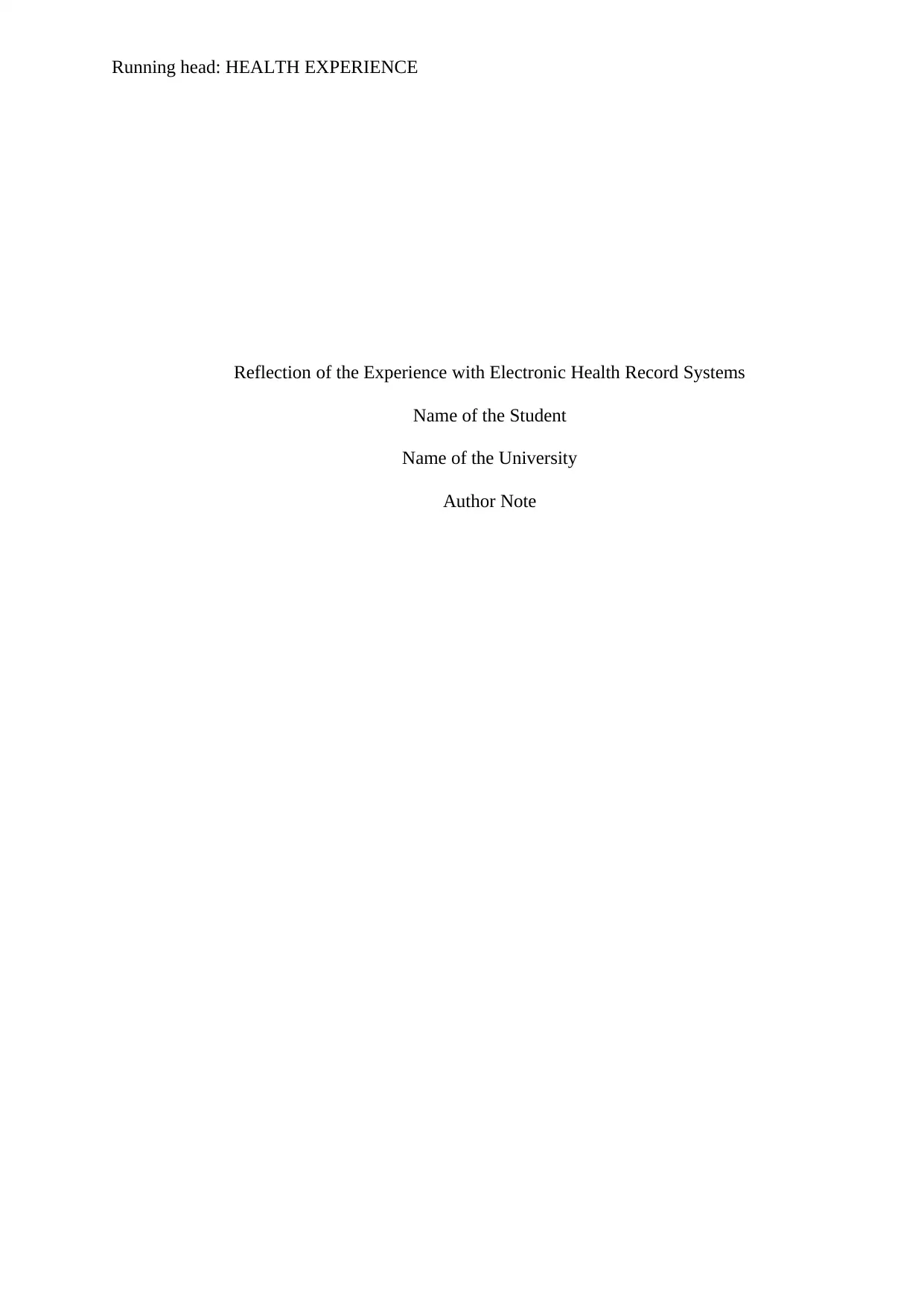
Running head: HEALTH EXPERIENCE
Reflection of the Experience with Electronic Health Record Systems
Name of the Student
Name of the University
Author Note
Reflection of the Experience with Electronic Health Record Systems
Name of the Student
Name of the University
Author Note
Paraphrase This Document
Need a fresh take? Get an instant paraphrase of this document with our AI Paraphraser
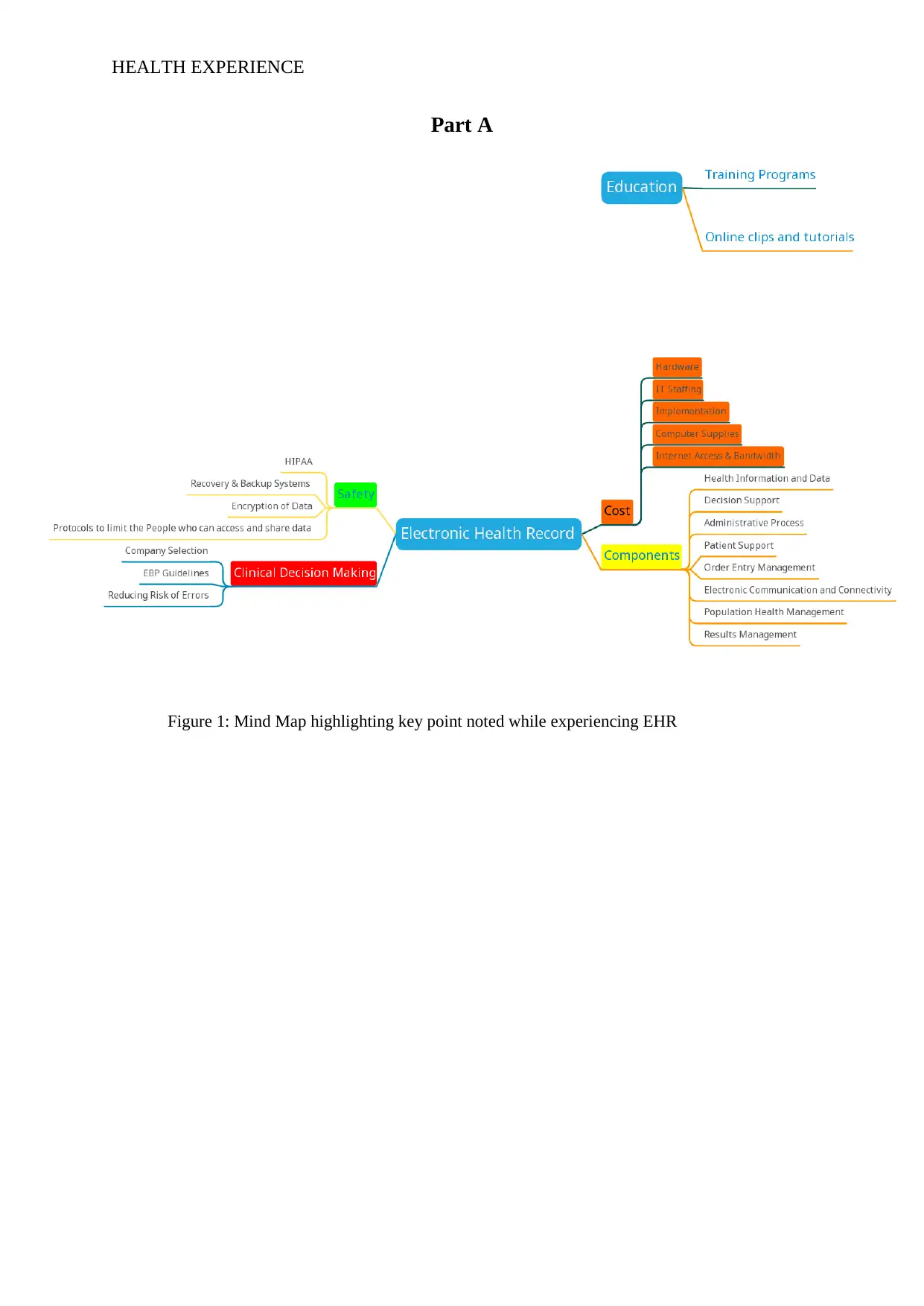
HEALTH EXPERIENCE
Part A
Figure 1: Mind Map highlighting key point noted while experiencing EHR
Part A
Figure 1: Mind Map highlighting key point noted while experiencing EHR
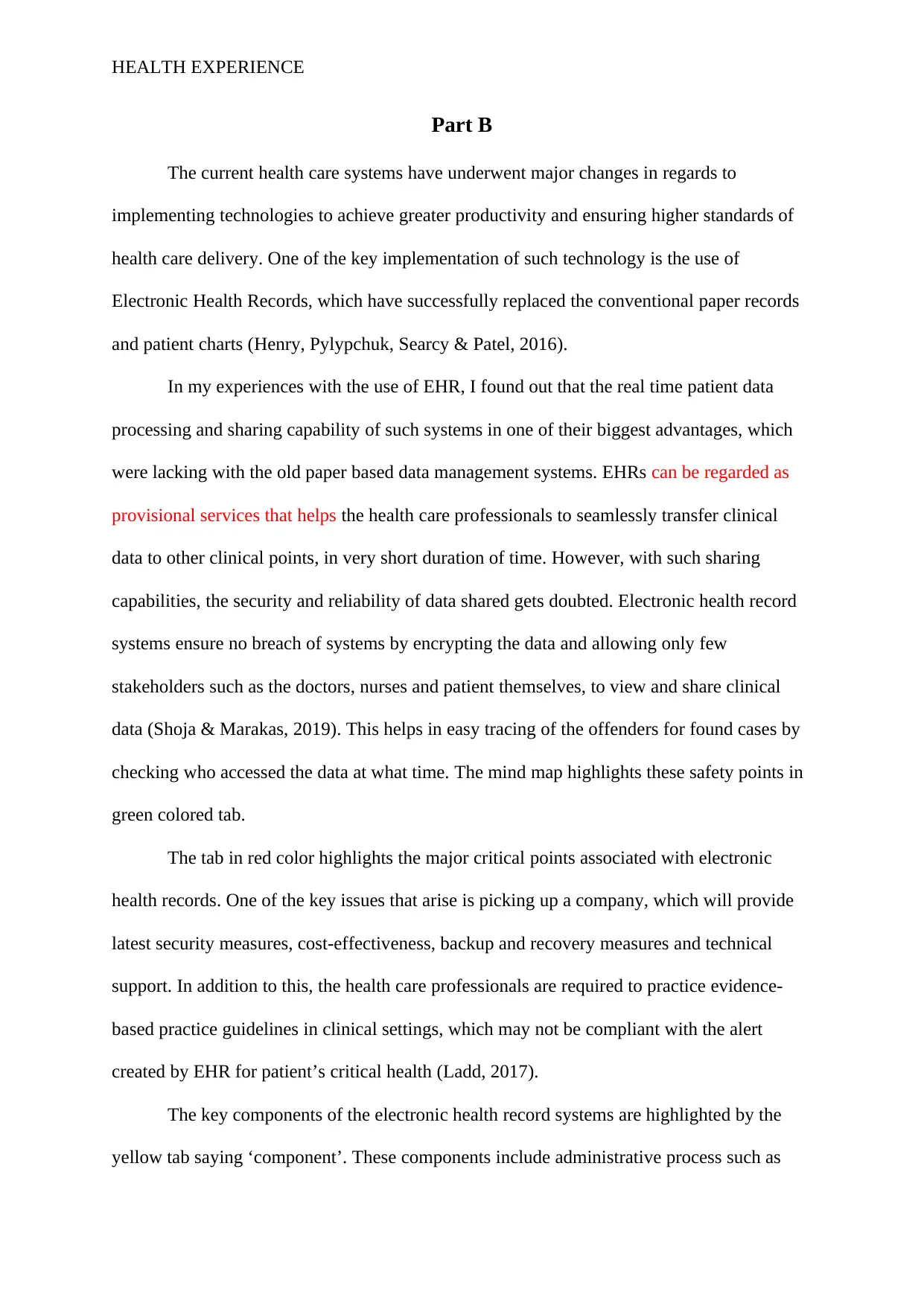
HEALTH EXPERIENCE
Part B
The current health care systems have underwent major changes in regards to
implementing technologies to achieve greater productivity and ensuring higher standards of
health care delivery. One of the key implementation of such technology is the use of
Electronic Health Records, which have successfully replaced the conventional paper records
and patient charts (Henry, Pylypchuk, Searcy & Patel, 2016).
In my experiences with the use of EHR, I found out that the real time patient data
processing and sharing capability of such systems in one of their biggest advantages, which
were lacking with the old paper based data management systems. EHRs can be regarded as
provisional services that helps the health care professionals to seamlessly transfer clinical
data to other clinical points, in very short duration of time. However, with such sharing
capabilities, the security and reliability of data shared gets doubted. Electronic health record
systems ensure no breach of systems by encrypting the data and allowing only few
stakeholders such as the doctors, nurses and patient themselves, to view and share clinical
data (Shoja & Marakas, 2019). This helps in easy tracing of the offenders for found cases by
checking who accessed the data at what time. The mind map highlights these safety points in
green colored tab.
The tab in red color highlights the major critical points associated with electronic
health records. One of the key issues that arise is picking up a company, which will provide
latest security measures, cost-effectiveness, backup and recovery measures and technical
support. In addition to this, the health care professionals are required to practice evidence-
based practice guidelines in clinical settings, which may not be compliant with the alert
created by EHR for patient’s critical health (Ladd, 2017).
The key components of the electronic health record systems are highlighted by the
yellow tab saying ‘component’. These components include administrative process such as
Part B
The current health care systems have underwent major changes in regards to
implementing technologies to achieve greater productivity and ensuring higher standards of
health care delivery. One of the key implementation of such technology is the use of
Electronic Health Records, which have successfully replaced the conventional paper records
and patient charts (Henry, Pylypchuk, Searcy & Patel, 2016).
In my experiences with the use of EHR, I found out that the real time patient data
processing and sharing capability of such systems in one of their biggest advantages, which
were lacking with the old paper based data management systems. EHRs can be regarded as
provisional services that helps the health care professionals to seamlessly transfer clinical
data to other clinical points, in very short duration of time. However, with such sharing
capabilities, the security and reliability of data shared gets doubted. Electronic health record
systems ensure no breach of systems by encrypting the data and allowing only few
stakeholders such as the doctors, nurses and patient themselves, to view and share clinical
data (Shoja & Marakas, 2019). This helps in easy tracing of the offenders for found cases by
checking who accessed the data at what time. The mind map highlights these safety points in
green colored tab.
The tab in red color highlights the major critical points associated with electronic
health records. One of the key issues that arise is picking up a company, which will provide
latest security measures, cost-effectiveness, backup and recovery measures and technical
support. In addition to this, the health care professionals are required to practice evidence-
based practice guidelines in clinical settings, which may not be compliant with the alert
created by EHR for patient’s critical health (Ladd, 2017).
The key components of the electronic health record systems are highlighted by the
yellow tab saying ‘component’. These components include administrative process such as
⊘ This is a preview!⊘
Do you want full access?
Subscribe today to unlock all pages.

Trusted by 1+ million students worldwide
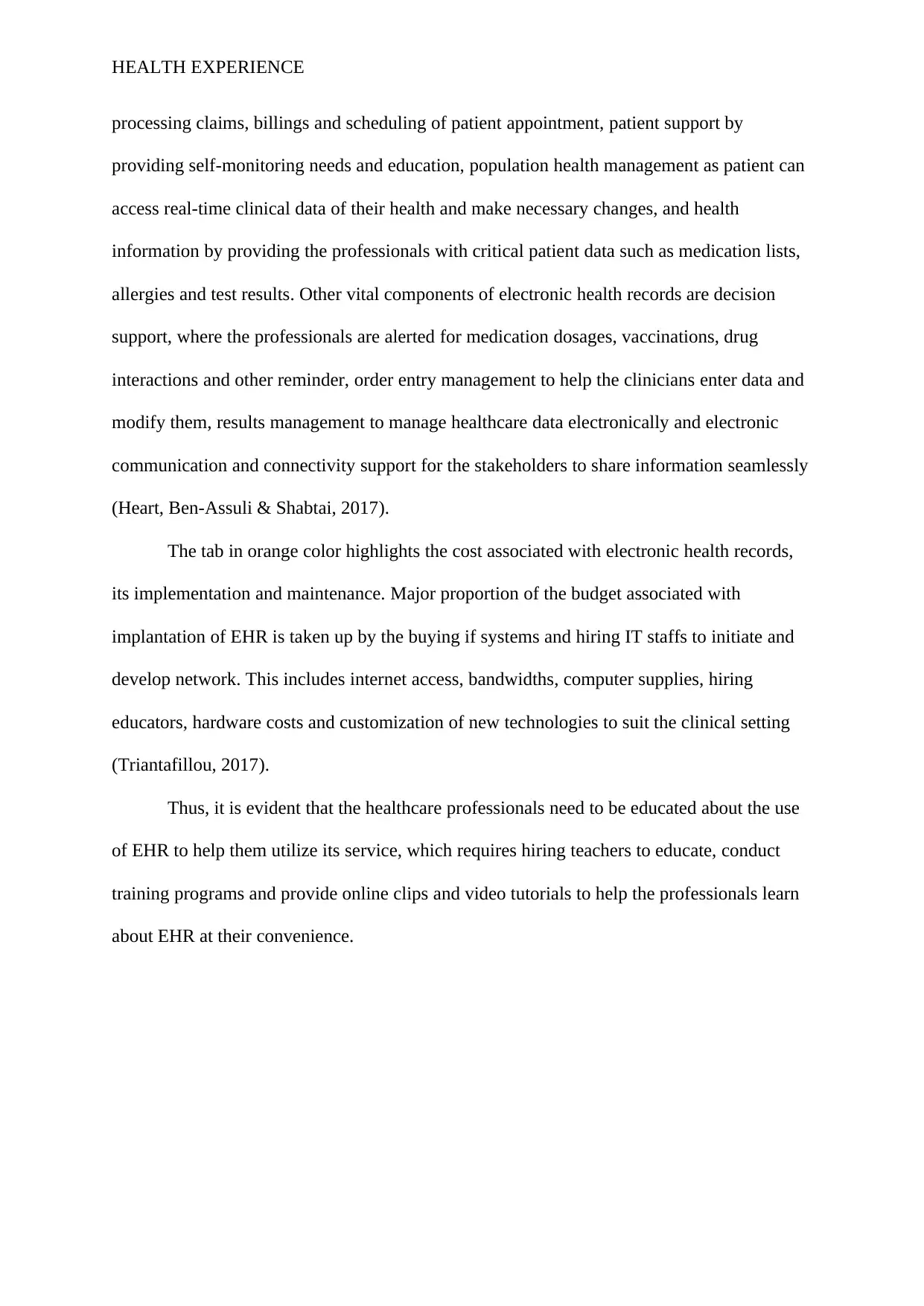
HEALTH EXPERIENCE
processing claims, billings and scheduling of patient appointment, patient support by
providing self-monitoring needs and education, population health management as patient can
access real-time clinical data of their health and make necessary changes, and health
information by providing the professionals with critical patient data such as medication lists,
allergies and test results. Other vital components of electronic health records are decision
support, where the professionals are alerted for medication dosages, vaccinations, drug
interactions and other reminder, order entry management to help the clinicians enter data and
modify them, results management to manage healthcare data electronically and electronic
communication and connectivity support for the stakeholders to share information seamlessly
(Heart, Ben-Assuli & Shabtai, 2017).
The tab in orange color highlights the cost associated with electronic health records,
its implementation and maintenance. Major proportion of the budget associated with
implantation of EHR is taken up by the buying if systems and hiring IT staffs to initiate and
develop network. This includes internet access, bandwidths, computer supplies, hiring
educators, hardware costs and customization of new technologies to suit the clinical setting
(Triantafillou, 2017).
Thus, it is evident that the healthcare professionals need to be educated about the use
of EHR to help them utilize its service, which requires hiring teachers to educate, conduct
training programs and provide online clips and video tutorials to help the professionals learn
about EHR at their convenience.
processing claims, billings and scheduling of patient appointment, patient support by
providing self-monitoring needs and education, population health management as patient can
access real-time clinical data of their health and make necessary changes, and health
information by providing the professionals with critical patient data such as medication lists,
allergies and test results. Other vital components of electronic health records are decision
support, where the professionals are alerted for medication dosages, vaccinations, drug
interactions and other reminder, order entry management to help the clinicians enter data and
modify them, results management to manage healthcare data electronically and electronic
communication and connectivity support for the stakeholders to share information seamlessly
(Heart, Ben-Assuli & Shabtai, 2017).
The tab in orange color highlights the cost associated with electronic health records,
its implementation and maintenance. Major proportion of the budget associated with
implantation of EHR is taken up by the buying if systems and hiring IT staffs to initiate and
develop network. This includes internet access, bandwidths, computer supplies, hiring
educators, hardware costs and customization of new technologies to suit the clinical setting
(Triantafillou, 2017).
Thus, it is evident that the healthcare professionals need to be educated about the use
of EHR to help them utilize its service, which requires hiring teachers to educate, conduct
training programs and provide online clips and video tutorials to help the professionals learn
about EHR at their convenience.
Paraphrase This Document
Need a fresh take? Get an instant paraphrase of this document with our AI Paraphraser
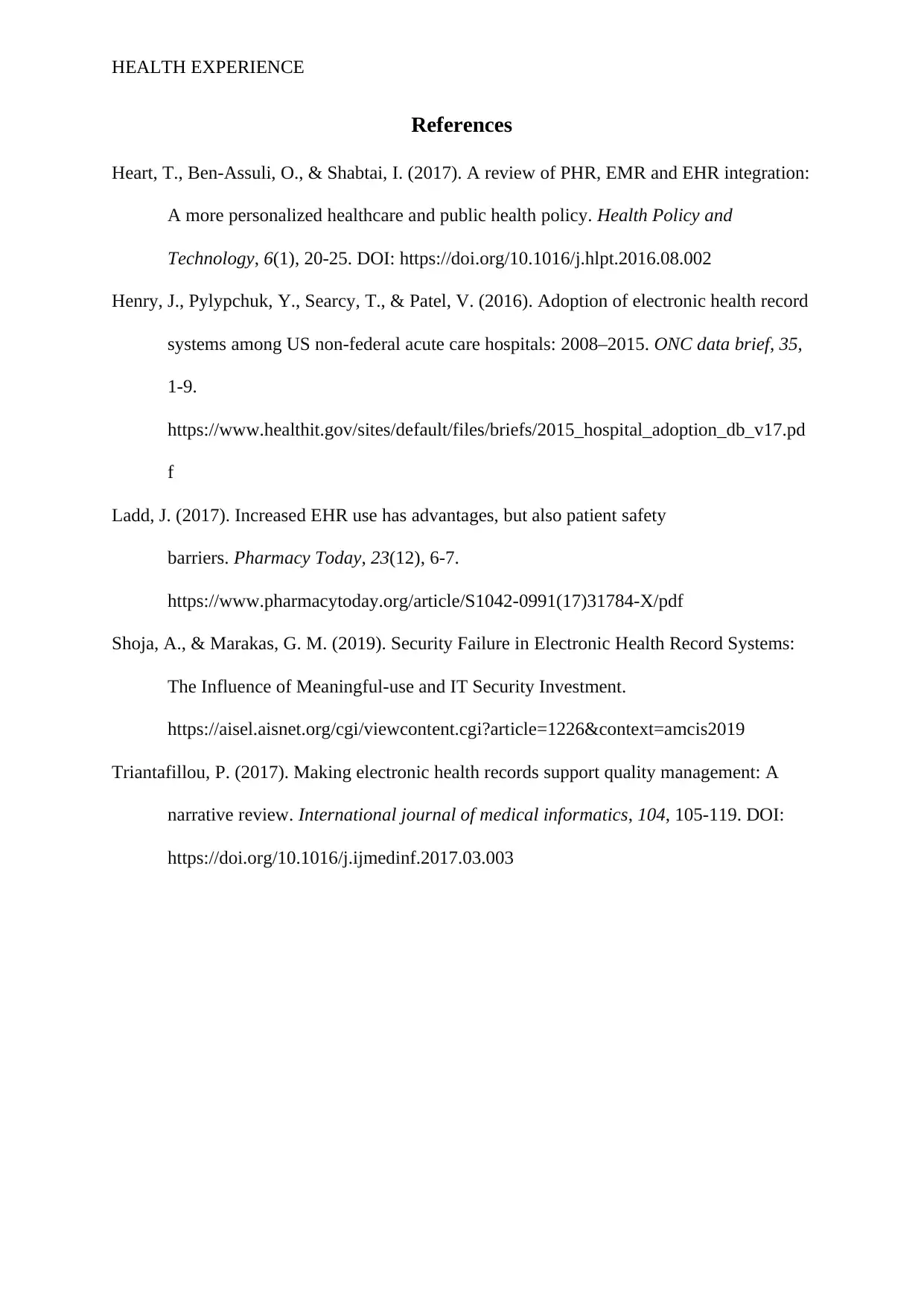
HEALTH EXPERIENCE
References
Heart, T., Ben-Assuli, O., & Shabtai, I. (2017). A review of PHR, EMR and EHR integration:
A more personalized healthcare and public health policy. Health Policy and
Technology, 6(1), 20-25. DOI: https://doi.org/10.1016/j.hlpt.2016.08.002
Henry, J., Pylypchuk, Y., Searcy, T., & Patel, V. (2016). Adoption of electronic health record
systems among US non-federal acute care hospitals: 2008–2015. ONC data brief, 35,
1-9.
https://www.healthit.gov/sites/default/files/briefs/2015_hospital_adoption_db_v17.pd
f
Ladd, J. (2017). Increased EHR use has advantages, but also patient safety
barriers. Pharmacy Today, 23(12), 6-7.
https://www.pharmacytoday.org/article/S1042-0991(17)31784-X/pdf
Shoja, A., & Marakas, G. M. (2019). Security Failure in Electronic Health Record Systems:
The Influence of Meaningful-use and IT Security Investment.
https://aisel.aisnet.org/cgi/viewcontent.cgi?article=1226&context=amcis2019
Triantafillou, P. (2017). Making electronic health records support quality management: A
narrative review. International journal of medical informatics, 104, 105-119. DOI:
https://doi.org/10.1016/j.ijmedinf.2017.03.003
References
Heart, T., Ben-Assuli, O., & Shabtai, I. (2017). A review of PHR, EMR and EHR integration:
A more personalized healthcare and public health policy. Health Policy and
Technology, 6(1), 20-25. DOI: https://doi.org/10.1016/j.hlpt.2016.08.002
Henry, J., Pylypchuk, Y., Searcy, T., & Patel, V. (2016). Adoption of electronic health record
systems among US non-federal acute care hospitals: 2008–2015. ONC data brief, 35,
1-9.
https://www.healthit.gov/sites/default/files/briefs/2015_hospital_adoption_db_v17.pd
f
Ladd, J. (2017). Increased EHR use has advantages, but also patient safety
barriers. Pharmacy Today, 23(12), 6-7.
https://www.pharmacytoday.org/article/S1042-0991(17)31784-X/pdf
Shoja, A., & Marakas, G. M. (2019). Security Failure in Electronic Health Record Systems:
The Influence of Meaningful-use and IT Security Investment.
https://aisel.aisnet.org/cgi/viewcontent.cgi?article=1226&context=amcis2019
Triantafillou, P. (2017). Making electronic health records support quality management: A
narrative review. International journal of medical informatics, 104, 105-119. DOI:
https://doi.org/10.1016/j.ijmedinf.2017.03.003
1 out of 5
Related Documents
Your All-in-One AI-Powered Toolkit for Academic Success.
+13062052269
info@desklib.com
Available 24*7 on WhatsApp / Email
![[object Object]](/_next/static/media/star-bottom.7253800d.svg)
Unlock your academic potential
Copyright © 2020–2025 A2Z Services. All Rights Reserved. Developed and managed by ZUCOL.




